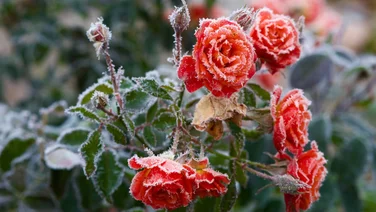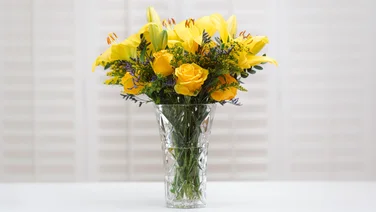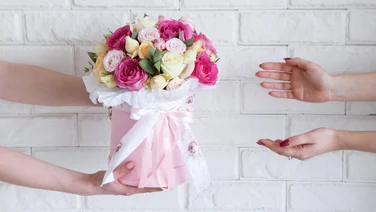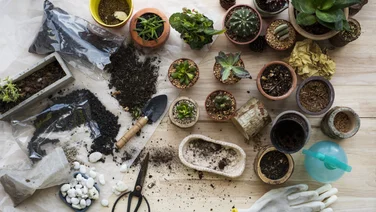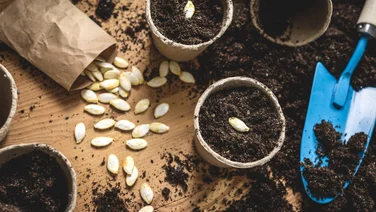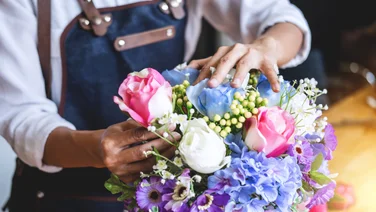To help us provide you with free impartial advice, we may earn a commission if you buy through links on our site. Learn more
- Best plants for hanging baskets: At a glance
- How to choose the best plants for hanging baskets for you
- The best plants for hanging baskets you can buy in 2023
- 1. Fuchsia “Dark Eyes”: Best for those on a budget
- 2. Nepeta Variegated: Best for foliage
- 3. Calibrachoa: Best for long-lasting flowers
- 4. Begonias: Best for big blooms
- 5. Bidens: Best for attracting pollinators
- 6. Tomatoes: Best for a hanging basket with a difference

The best plants for hanging baskets are a great invention, allowing anyone with a garden, yard or even just windows to add a splash of colour and vibrancy to their world. They can add kerb appeal to the front of a house, help beautify dull patios or concrete backyards, and brighten up walls and fences in the garden.
Because the plants are in a basket, they’re easy to move around and play with different colours and looks. They’re a great choice for the novice gardener as well, giving them a small space to experiment in without having to worry if things go wrong. Best of all, many of the best options for hanging baskets have a long season of bloom, which means you’ll have vibrant colours for several months of the year.
We’ve put together a buying guide below to help you with any questions you might have, or just scroll down to see our recommendations for the best plants for hanging baskets.
Best plants for hanging baskets: At a glance
- Best for those on a budget: Fuchsia | £5.99
- Best for foliage: Nepeta Variegated | £6.99
- Best for long-lasting flowers: Calibrachoa | £14
- Best for attracting pollinators: Bidens | £6.99
How to choose the best plants for hanging baskets for you
Hanging baskets can look beautiful, but where do you start if you want to put one together? Here are the things you need to know.
What plants should you choose?
When you’re making up a hanging basket, you want a combination of plants that can best be described as thrillers, spillers and fillers.
Thriller plants are the large and colourful flowers that will first draw people’s attention to a hanging basket. These plants should stand out from the rest and are often used to add height to an arrangement.
Spiller plants are those that, as you might expect from the name, spill out or trail over the edge of the basket. Use these to add interest and depth to a hanging basket.
Finally, the filler plants will help plug the gaps between the thrillers and the spillers, and they are usually more low key, simply providing some background foliage and coverage to the basket.
Remember that it’s important to choose plants that are suitable for your local climate, particularly if they’re being hung outdoors. You should look for plants that have similar water and light requirements for their ongoing care. And try to choose complementary colours, so that your hanging basket doesn’t clash!
When should you start hanging baskets?
It’s advisable to start plants off early in the spring in order to give them time to establish. However, you’ll need to keep them in a greenhouse or a conservatory at first, at least until all the frosts have passed. If you haven’t got anywhere suitable to keep them undercover, we’d recommend waiting and planting your hanging baskets outside in mid to late spring.
Of course, you can also design winter hanging baskets. You should plant these early in autumn.
READ NEXT: The best gardening gloves to buy
How to plant a hanging basket
There are five quick and easy steps to put together a hanging basket, once you’ve chosen your flowers:
1. Line your basket – We recommend standing your basket on a short, wide plant pot for stability, then – assuming it isn’t already lined – lay either moss or a proprietary liner inside the frame and use scissors to cut to fit.
2. Create planting holes – Poke holes in the liner at various heights, making sure they’re at least 10cm from the base. Although planting through the sides isn’t essential, it’s worth it as it helps to make the basket look fuller more quickly.
3. Add peat-free compost and side plants – Add compost to the level of the cut holes. Wrap newspaper or old paper around the root balls of your plants and push them through the holes into the basket. Add more compost to cover the roots and gently push it down.
4. Plant the top of the basket – Plant your taller plants in the centre, and the shorter or trailing plants around the edge of your basket. Fill in with compost so that the level is just below the rim of the basket.
5. Water the basket – Water your hanging basket slowly, but thoroughly, before you hang it up. Make sure you check the compost regularly as, generally, you should water your hanging baskets when the compost is dry to the touch, but be aware that during hot summer weather you’ll probably need to water daily. Use a watering can with a fine rose to prevent disturbing the compost or, if you find the basket is too heavy to lift up and down, you could consider using a hosepipe on a fine spray setting.
Depending on what type of flowers you’ve chosen, you may want to give them the occasional liquid feed as well. And remember to regularly deadhead – snipping off the old, spent flower heads – as this can encourage further blooms.
READ NEXT: The best garden tools to buy
How we test hanging baskets
We spoke with both gardening experts and keen amateur gardeners to get a wide range of opinions on the most suitable plants to use in hanging baskets. We looked specifically for plants that are capable of surviving and flourishing in a changeable British summer, with hardiness being high on the list of requirements.
The best plants for hanging baskets you can buy in 2023
1. Fuchsia “Dark Eyes”: Best for those on a budget

Price when reviewed: £5.99 (for 6) | Check price at RG Plants
Fuchsias are a great choice for those on a tight budget, and they’re also a good option for those just starting out with hanging baskets, as they’re incredibly tough and don’t require a lot of attention for them to grow to their full potential.
Another benefit of fuchsias is that they’re perennials, so they can last for multiple seasons. However, in colder climates – such as the UK – you’ll need to keep them out of the frost in the winter, so that they grow back again the following year.
Fuchsias are available in shades of white, pink, purple and red, with different varieties combining two of these colours. Their distinctive hanging, bell-shaped, bi-coloured flowers make them a great spiller plant, and the range of colours makes it easy to find a variety that will match with most pre-existing colour schemes.
Key details – Type: Perennial; Flowering period: June to October; Position: Partial shade
2. Nepeta Variegated: Best for foliage

Price when reviewed: £6.99 (9cm pot) | Check price at RHS Plants
Hanging baskets don’t just need brightly coloured flowers. You also need foliage to fill in the gaps and add depth and bulk to your arrangement, which makes Nepeta Variegated – a semi-evergreen with a beautiful textured appearance – a good choice. This plant has green, scallop-shaped leaves and grows lilac flowers in summer that attract pollinators such as bees and butterflies (so it’s good for the environment as well).
This is an incredibly hardy plant that’s easy to grow and maintain, and its trailing appearance makes it useful as both a filler and spiller plant. It can also be grown as spreading cover on the ground, although it does tend to become a little invasive.
During winter, the plant will lose some or all of its leaves, but fresh growth appears again in spring, though it will need a tidy, and dead foliage cutting back, before new leaves start to emerge. Because of its ability to survive, you’ll need to divide the plant every two or three years, but this just means you’ll have enough to start another hanging basket!
Key details – Type: Perennial; Flowering period: April to May; Position: Full sun or partial shade
3. Calibrachoa: Best for long-lasting flowers

Price when reviewed: £14 (for 6) | Check price at Amazon
Calibrachoas are a miniature variety of petunias that produce masses of gorgeous trailing flowers. They’re also known as “million bells”, “trailing petunias” and “superbells”. They come in a huge range of colours, including white, coral, yellow, magenta, red, pink, blue and lavender, and they’ll flower for weeks on end. Originally native to South America, calibrachoas have a sprawling habit that makes them a great option for hanging baskets, and they can be used to break up foliage with dashes of colour. They also, in our opinion, work particularly well with fuchsias.
In the 1990s, plant breeders started to produce hybrids that grow in gardens and we’re now seeing plants that can cope with the unpredictable British weather. However, while they’re classed as a perennial, calibrachoas won’t survive the colder temperatures of the UK autumn and winter, so they need to be treated as annuals and discarded at the end of the summer.
Key details – Type: Perennial (annual in the UK); Flowering period: All summer; Position: Partial shade
4. Begonias: Best for big blooms

Price when reviewed: £4.99 (2 tubers) | Check price at RHS Plants
If you want a showstopping flower in your hanging baskets, begonias are always a good choice. These impressively flamboyant blooms grow big and make a great thriller for the top of your hanging basket. The Begonia “Splendide Ballerina” that we’ve chosen here, for example, can grow flowers up to 15cm across.
Begonias come in a wide variety of colours – from a striking bright red through to gentle pastel apricot – making it easy to find a plant that will match your colour palette. Best of all, begonias will flower repeatedly over the summer months, and can then be kept under cover over winter to re-flower the following year. That said, they are a tender plant that requires proper protection from frost, so you’ll need to keep them in a greenhouse through the winter, although a conservatory may do the job as well.
Key details – Type: Perennial; Flowering period: May to the first frosts; Position: Full sun or partial shade
5. Bidens: Best for attracting pollinators

Price when reviewed: £6.99 (9cm pot) | Check price at RHS Plants
It’s important to encourage pollinators into our gardens, and bidens are a plant particularly attractive to both bees and butterflies. Bidens – you might also hear them called “Spanish needles”, “tickseed sunflowers” or “beggarticks” – are prolific flowering plants with daisy-like blooms that work particularly well as a spiller plant in hanging baskets. Traditionally, bidens are yellow or orange, but newer varieties have pink, gold or white blossoms.
Like calibrachoas, bidens are perennial plants in warmer climates, but are annuals in the UK as they can’t cope with freezing temperatures. Bidens need sun to thrive, so should be placed somewhere they’ll get at least six hours of direct sunlight per day to produce the best blooms. They will still grow without adequate light, but won’t produce as many flowers. They’re also incredibly easy to maintain as they don’t need to be pruned or deadheaded.
Key details – Type: Perennial (annual in the UK); Flowering period: June to the first frosts; Position: Full sun
6. Tomatoes: Best for a hanging basket with a difference

Price when reviewed: £2.99 | Check price at Dobies
Of course, hanging baskets don’t have to just be for flowers. If you fancy growing your own fruits or vegetables but are limited on space, then growing them in a hanging basket could be the perfect solution. Ideal for small gardens or balconies, you could choose to focus on one fruit or vegetable, or you could grow a variety, particularly if they have the same care requirements.
There are lots of varieties of tomatoes that will work in hanging baskets, but we’ve chosen seeds that will produce long stems of tomatoes – we find these small, cherry tomatoes work best as they have long, ropey vines to trail over the basket’s edges. To grow them successfully, tomatoes need around eight hours of sunlight, so look for somewhere on the south side of your home to hang them. Tomato plants can also be heavier than flowers, so make sure you use a sturdy basket, installed with adequate support.
Key details – Type: Fruit; Flowering period: Harvest from June to September; Position: Full sun






